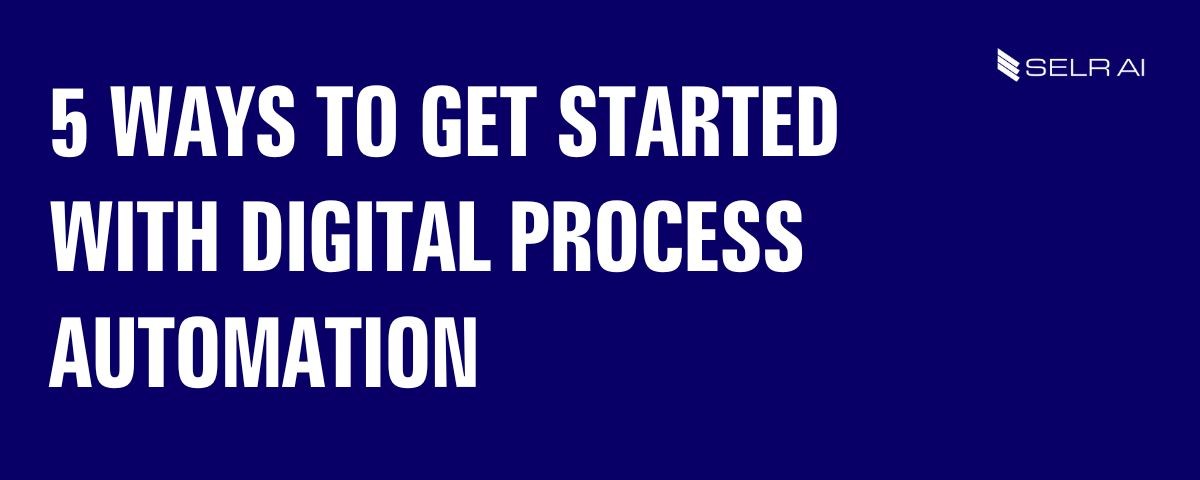Aug 14, 2024
5 Ways to Get Started with Digital Process Automation
5 Ways to Get Started with Digital Process Automation
5 Ways to Get Started with Digital Process Automation
5 Ways to Get Started with Digital Process Automation

Luke Heka
Luke Heka



1. Diving into the Basics
Digital process automation is transforming the way businesses operate in today's fast-paced digital world. It involves using technology to automate manual tasks, streamline processes, and improve efficiency. By embracing digital process automation, organisations can save time, reduce errors, and enhance productivity across various departments.
At its core, digital process automation aims to simplify and optimise workflows by automating repetitive tasks that were traditionally done manually. This not only frees up valuable time for employees to focus on more strategic initiatives but also ensures consistency and accuracy in the execution of processes.
One of the key benefits of digital process automation is its ability to integrate with existing systems and applications, creating a seamless digital ecosystem. This interconnectedness allows for the smooth flow of data and information between different software tools, eliminating silos and facilitating better collaboration among teams.
By automating routine tasks such as data entry, document approvals, and report generation, digital process automation can significantly reduce the likelihood of errors that can occur with manual intervention. This leads to greater data accuracy, improved compliance, and enhanced decision-making based on real-time insights.
2. Understanding the Core Concepts
To kickstart your journey into digital process automation, it's essential to understand the core concepts that underpin this transformative technology. Workflow automation, business process management, and robotic process automation are some of the foundational elements that drive digital process automation initiatives.
Workflow automation focuses on automating sequential tasks within a process, ensuring that each step flows seamlessly into the next. Business process management, on the other hand, involves optimising end-to-end processes by analysing, designing, executing, monitoring, and optimising workflows for maximum efficiency.
Robotic process automation (RPA) plays a crucial role in automating rule-based, repetitive tasks by leveraging software robots to mimic human interactions with digital systems. These can come as AI Call agents, bots and more. This technology empowers organisations to automate manual processes without the need for extensive reengineering of existing systems.
3. Implementing Your First Automation
Embarking on your first automation project can be both exciting and overwhelming. Start by evaluating your current workflows to identify repetitive tasks that are prime candidates for automation. Look for processes that are rule-based, time-consuming, and prone to human error.
Once you've identified potential automation opportunities, prioritise them based on their impact on efficiency and scalability. Begin by automating simple, low-risk processes to build confidence in the technology and demonstrate quick wins to key stakeholders.
Collaborate with cross-functional teams to gather insights and feedback on the automation implementation. This collaborative approach ensures that the automated processes align with the needs of different departments and stakeholders, driving successful adoption of digital process automation across the organisation.
Monitor the performance of your automated processes closely to track key metrics such as processing time, error rates, and cost savings. By analysing these metrics, you can continuously optimise and refine your automation strategies to achieve greater efficiency, productivity, and ROI.
4. Exploring Automation Tools and Software
Choosing the right automation tools and software is critical to the success of your digital process automation initiatives. Look for tools that offer a user-friendly interface, scalability, integration capabilities, and robust security features to support your automation needs.
Consider implementing a combination of workflow automation software, business process management platforms, and robotic process automation tools to address various automation requirements within your organisation. Integration between these tools is key to creating a cohesive and efficient automation ecosystem.
Explore cloud-based automation solutions that provide flexibility, scalability, and accessibility across different departments and locations. Cloud automation platforms offer the advantage of remote access, real-time collaboration, and seamless updates, ensuring that your automation processes stay agile and responsive to changing business needs.
5. Optimising Efficiency and Performance
As you progress in your digital process automation journey, focus on optimising the efficiency and performance of your automated processes. Continuously seek feedback from users and stakeholders to identify bottlenecks, areas for improvement, and new automation opportunities.
Utilise analytics and reporting tools to gather insights into the performance of your automated workflows. Key performance indicators (KPIs) such as cycle time, throughput, error rates, and cost savings can help you measure the impact of automation on your organisation's operations and strategic goals.
Implement process monitoring and exception handling mechanisms to address any issues that may arise during the automation process. By proactively managing exceptions and errors, you can ensure the smooth operation of your automated workflows and maintain high levels of productivity and efficiency.
Get started with automating your digital processes, click here.
1. Diving into the Basics
Digital process automation is transforming the way businesses operate in today's fast-paced digital world. It involves using technology to automate manual tasks, streamline processes, and improve efficiency. By embracing digital process automation, organisations can save time, reduce errors, and enhance productivity across various departments.
At its core, digital process automation aims to simplify and optimise workflows by automating repetitive tasks that were traditionally done manually. This not only frees up valuable time for employees to focus on more strategic initiatives but also ensures consistency and accuracy in the execution of processes.
One of the key benefits of digital process automation is its ability to integrate with existing systems and applications, creating a seamless digital ecosystem. This interconnectedness allows for the smooth flow of data and information between different software tools, eliminating silos and facilitating better collaboration among teams.
By automating routine tasks such as data entry, document approvals, and report generation, digital process automation can significantly reduce the likelihood of errors that can occur with manual intervention. This leads to greater data accuracy, improved compliance, and enhanced decision-making based on real-time insights.
2. Understanding the Core Concepts
To kickstart your journey into digital process automation, it's essential to understand the core concepts that underpin this transformative technology. Workflow automation, business process management, and robotic process automation are some of the foundational elements that drive digital process automation initiatives.
Workflow automation focuses on automating sequential tasks within a process, ensuring that each step flows seamlessly into the next. Business process management, on the other hand, involves optimising end-to-end processes by analysing, designing, executing, monitoring, and optimising workflows for maximum efficiency.
Robotic process automation (RPA) plays a crucial role in automating rule-based, repetitive tasks by leveraging software robots to mimic human interactions with digital systems. These can come as AI Call agents, bots and more. This technology empowers organisations to automate manual processes without the need for extensive reengineering of existing systems.
3. Implementing Your First Automation
Embarking on your first automation project can be both exciting and overwhelming. Start by evaluating your current workflows to identify repetitive tasks that are prime candidates for automation. Look for processes that are rule-based, time-consuming, and prone to human error.
Once you've identified potential automation opportunities, prioritise them based on their impact on efficiency and scalability. Begin by automating simple, low-risk processes to build confidence in the technology and demonstrate quick wins to key stakeholders.
Collaborate with cross-functional teams to gather insights and feedback on the automation implementation. This collaborative approach ensures that the automated processes align with the needs of different departments and stakeholders, driving successful adoption of digital process automation across the organisation.
Monitor the performance of your automated processes closely to track key metrics such as processing time, error rates, and cost savings. By analysing these metrics, you can continuously optimise and refine your automation strategies to achieve greater efficiency, productivity, and ROI.
4. Exploring Automation Tools and Software
Choosing the right automation tools and software is critical to the success of your digital process automation initiatives. Look for tools that offer a user-friendly interface, scalability, integration capabilities, and robust security features to support your automation needs.
Consider implementing a combination of workflow automation software, business process management platforms, and robotic process automation tools to address various automation requirements within your organisation. Integration between these tools is key to creating a cohesive and efficient automation ecosystem.
Explore cloud-based automation solutions that provide flexibility, scalability, and accessibility across different departments and locations. Cloud automation platforms offer the advantage of remote access, real-time collaboration, and seamless updates, ensuring that your automation processes stay agile and responsive to changing business needs.
5. Optimising Efficiency and Performance
As you progress in your digital process automation journey, focus on optimising the efficiency and performance of your automated processes. Continuously seek feedback from users and stakeholders to identify bottlenecks, areas for improvement, and new automation opportunities.
Utilise analytics and reporting tools to gather insights into the performance of your automated workflows. Key performance indicators (KPIs) such as cycle time, throughput, error rates, and cost savings can help you measure the impact of automation on your organisation's operations and strategic goals.
Implement process monitoring and exception handling mechanisms to address any issues that may arise during the automation process. By proactively managing exceptions and errors, you can ensure the smooth operation of your automated workflows and maintain high levels of productivity and efficiency.
Get started with automating your digital processes, click here.
1. Diving into the Basics
Digital process automation is transforming the way businesses operate in today's fast-paced digital world. It involves using technology to automate manual tasks, streamline processes, and improve efficiency. By embracing digital process automation, organisations can save time, reduce errors, and enhance productivity across various departments.
At its core, digital process automation aims to simplify and optimise workflows by automating repetitive tasks that were traditionally done manually. This not only frees up valuable time for employees to focus on more strategic initiatives but also ensures consistency and accuracy in the execution of processes.
One of the key benefits of digital process automation is its ability to integrate with existing systems and applications, creating a seamless digital ecosystem. This interconnectedness allows for the smooth flow of data and information between different software tools, eliminating silos and facilitating better collaboration among teams.
By automating routine tasks such as data entry, document approvals, and report generation, digital process automation can significantly reduce the likelihood of errors that can occur with manual intervention. This leads to greater data accuracy, improved compliance, and enhanced decision-making based on real-time insights.
2. Understanding the Core Concepts
To kickstart your journey into digital process automation, it's essential to understand the core concepts that underpin this transformative technology. Workflow automation, business process management, and robotic process automation are some of the foundational elements that drive digital process automation initiatives.
Workflow automation focuses on automating sequential tasks within a process, ensuring that each step flows seamlessly into the next. Business process management, on the other hand, involves optimising end-to-end processes by analysing, designing, executing, monitoring, and optimising workflows for maximum efficiency.
Robotic process automation (RPA) plays a crucial role in automating rule-based, repetitive tasks by leveraging software robots to mimic human interactions with digital systems. These can come as AI Call agents, bots and more. This technology empowers organisations to automate manual processes without the need for extensive reengineering of existing systems.
3. Implementing Your First Automation
Embarking on your first automation project can be both exciting and overwhelming. Start by evaluating your current workflows to identify repetitive tasks that are prime candidates for automation. Look for processes that are rule-based, time-consuming, and prone to human error.
Once you've identified potential automation opportunities, prioritise them based on their impact on efficiency and scalability. Begin by automating simple, low-risk processes to build confidence in the technology and demonstrate quick wins to key stakeholders.
Collaborate with cross-functional teams to gather insights and feedback on the automation implementation. This collaborative approach ensures that the automated processes align with the needs of different departments and stakeholders, driving successful adoption of digital process automation across the organisation.
Monitor the performance of your automated processes closely to track key metrics such as processing time, error rates, and cost savings. By analysing these metrics, you can continuously optimise and refine your automation strategies to achieve greater efficiency, productivity, and ROI.
4. Exploring Automation Tools and Software
Choosing the right automation tools and software is critical to the success of your digital process automation initiatives. Look for tools that offer a user-friendly interface, scalability, integration capabilities, and robust security features to support your automation needs.
Consider implementing a combination of workflow automation software, business process management platforms, and robotic process automation tools to address various automation requirements within your organisation. Integration between these tools is key to creating a cohesive and efficient automation ecosystem.
Explore cloud-based automation solutions that provide flexibility, scalability, and accessibility across different departments and locations. Cloud automation platforms offer the advantage of remote access, real-time collaboration, and seamless updates, ensuring that your automation processes stay agile and responsive to changing business needs.
5. Optimising Efficiency and Performance
As you progress in your digital process automation journey, focus on optimising the efficiency and performance of your automated processes. Continuously seek feedback from users and stakeholders to identify bottlenecks, areas for improvement, and new automation opportunities.
Utilise analytics and reporting tools to gather insights into the performance of your automated workflows. Key performance indicators (KPIs) such as cycle time, throughput, error rates, and cost savings can help you measure the impact of automation on your organisation's operations and strategic goals.
Implement process monitoring and exception handling mechanisms to address any issues that may arise during the automation process. By proactively managing exceptions and errors, you can ensure the smooth operation of your automated workflows and maintain high levels of productivity and efficiency.
Get started with automating your digital processes, click here.
1. Diving into the Basics
Digital process automation is transforming the way businesses operate in today's fast-paced digital world. It involves using technology to automate manual tasks, streamline processes, and improve efficiency. By embracing digital process automation, organisations can save time, reduce errors, and enhance productivity across various departments.
At its core, digital process automation aims to simplify and optimise workflows by automating repetitive tasks that were traditionally done manually. This not only frees up valuable time for employees to focus on more strategic initiatives but also ensures consistency and accuracy in the execution of processes.
One of the key benefits of digital process automation is its ability to integrate with existing systems and applications, creating a seamless digital ecosystem. This interconnectedness allows for the smooth flow of data and information between different software tools, eliminating silos and facilitating better collaboration among teams.
By automating routine tasks such as data entry, document approvals, and report generation, digital process automation can significantly reduce the likelihood of errors that can occur with manual intervention. This leads to greater data accuracy, improved compliance, and enhanced decision-making based on real-time insights.
2. Understanding the Core Concepts
To kickstart your journey into digital process automation, it's essential to understand the core concepts that underpin this transformative technology. Workflow automation, business process management, and robotic process automation are some of the foundational elements that drive digital process automation initiatives.
Workflow automation focuses on automating sequential tasks within a process, ensuring that each step flows seamlessly into the next. Business process management, on the other hand, involves optimising end-to-end processes by analysing, designing, executing, monitoring, and optimising workflows for maximum efficiency.
Robotic process automation (RPA) plays a crucial role in automating rule-based, repetitive tasks by leveraging software robots to mimic human interactions with digital systems. These can come as AI Call agents, bots and more. This technology empowers organisations to automate manual processes without the need for extensive reengineering of existing systems.
3. Implementing Your First Automation
Embarking on your first automation project can be both exciting and overwhelming. Start by evaluating your current workflows to identify repetitive tasks that are prime candidates for automation. Look for processes that are rule-based, time-consuming, and prone to human error.
Once you've identified potential automation opportunities, prioritise them based on their impact on efficiency and scalability. Begin by automating simple, low-risk processes to build confidence in the technology and demonstrate quick wins to key stakeholders.
Collaborate with cross-functional teams to gather insights and feedback on the automation implementation. This collaborative approach ensures that the automated processes align with the needs of different departments and stakeholders, driving successful adoption of digital process automation across the organisation.
Monitor the performance of your automated processes closely to track key metrics such as processing time, error rates, and cost savings. By analysing these metrics, you can continuously optimise and refine your automation strategies to achieve greater efficiency, productivity, and ROI.
4. Exploring Automation Tools and Software
Choosing the right automation tools and software is critical to the success of your digital process automation initiatives. Look for tools that offer a user-friendly interface, scalability, integration capabilities, and robust security features to support your automation needs.
Consider implementing a combination of workflow automation software, business process management platforms, and robotic process automation tools to address various automation requirements within your organisation. Integration between these tools is key to creating a cohesive and efficient automation ecosystem.
Explore cloud-based automation solutions that provide flexibility, scalability, and accessibility across different departments and locations. Cloud automation platforms offer the advantage of remote access, real-time collaboration, and seamless updates, ensuring that your automation processes stay agile and responsive to changing business needs.
5. Optimising Efficiency and Performance
As you progress in your digital process automation journey, focus on optimising the efficiency and performance of your automated processes. Continuously seek feedback from users and stakeholders to identify bottlenecks, areas for improvement, and new automation opportunities.
Utilise analytics and reporting tools to gather insights into the performance of your automated workflows. Key performance indicators (KPIs) such as cycle time, throughput, error rates, and cost savings can help you measure the impact of automation on your organisation's operations and strategic goals.
Implement process monitoring and exception handling mechanisms to address any issues that may arise during the automation process. By proactively managing exceptions and errors, you can ensure the smooth operation of your automated workflows and maintain high levels of productivity and efficiency.
Get started with automating your digital processes, click here.
Latest Blogs


